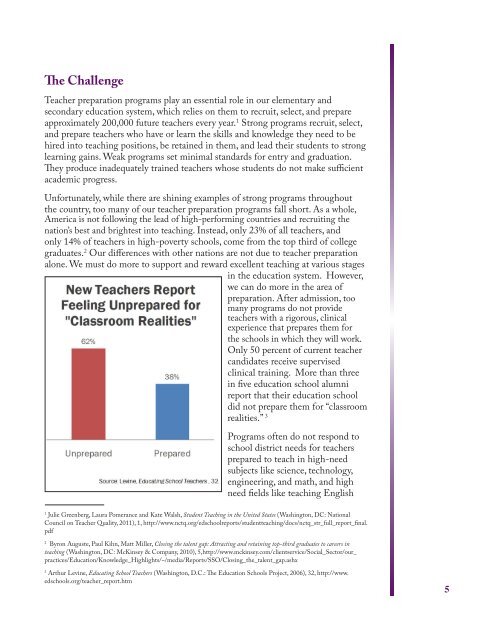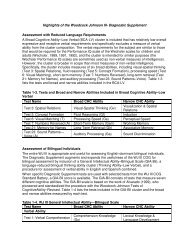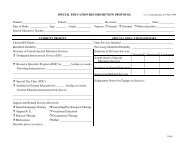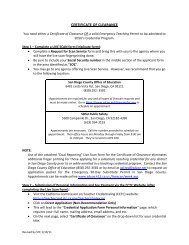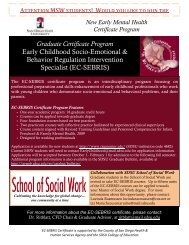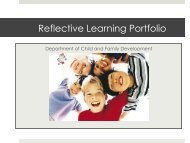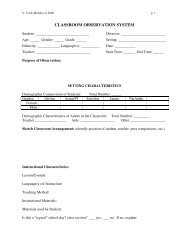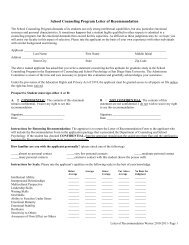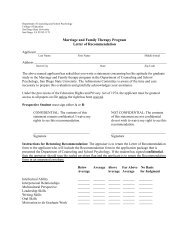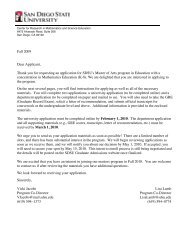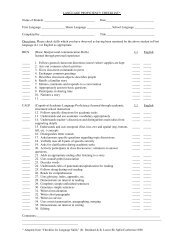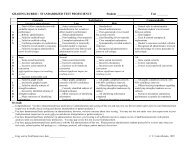Our Future, Our Teachers - U.S. Department of Education
Our Future, Our Teachers - U.S. Department of Education
Our Future, Our Teachers - U.S. Department of Education
You also want an ePaper? Increase the reach of your titles
YUMPU automatically turns print PDFs into web optimized ePapers that Google loves.
The ChallengeTeacher preparation programs play an essential role in our elementary andsecondary education system, which relies on them to recruit, select, and prepareapproximately 200,000 future teachers every year. 1 Strong programs recruit, select,and prepare teachers who have or learn the skills and knowledge they need to behired into teaching positions, be retained in them, and lead their students to stronglearning gains. Weak programs set minimal standards for entry and graduation.They produce inadequately trained teachers whose students do not make sufficientacademic progress.Unfortunately, while there are shining examples <strong>of</strong> strong programs throughoutthe country, too many <strong>of</strong> our teacher preparation programs fall short. As a whole,America is not following the lead <strong>of</strong> high-performing countries and recruiting thenation’s best and brightest into teaching. Instead, only 23% <strong>of</strong> all teachers, andonly 14% <strong>of</strong> teachers in high-poverty schools, come from the top third <strong>of</strong> collegegraduates. 2 <strong>Our</strong> differences with other nations are not due to teacher preparationalone. We must do more to support and reward excellent teaching at various stagesin the education system. However,we can do more in the area <strong>of</strong>preparation. After admission, toomany programs do not provideteachers with a rigorous, clinicalexperience that prepares them forthe schools in which they will work.Only 50 percent <strong>of</strong> current teachercandidates receive supervisedclinical training. More than threein five education school alumnireport that their education schooldid not prepare them for “classroomrealities.” 3Programs <strong>of</strong>ten do not respond toschool district needs for teachersprepared to teach in high-needsubjects like science, technology,engineering, and math, and highneed fields like teaching English1Julie Greenberg, Laura Pomerance and Kate Walsh, Student Teaching in the United States (Washington, DC: NationalCouncil on Teacher Quality, 2011), 1, http://www.nctq.org/edschoolreports/studentteaching/docs/nctq_str_full_report_final.pdf2Byron Auguste, Paul Kihn, Matt Miller, Closing the talent gap: Attracting and retaining top-third graduates to careers inteaching (Washington, DC: McKinsey & Company, 2010), 5,http://www.mckinsey.com/clientservice/Social_Sector/our_practices/<strong>Education</strong>/Knowledge_Highlights/~/media/Reports/SSO/Closing_the_talent_gap.ashx3Arthur Levine, Educating School <strong>Teachers</strong> (Washington, D.C.: The <strong>Education</strong> Schools Project, 2006), 32, http://www.edschools.org/teacher_report.htm5


